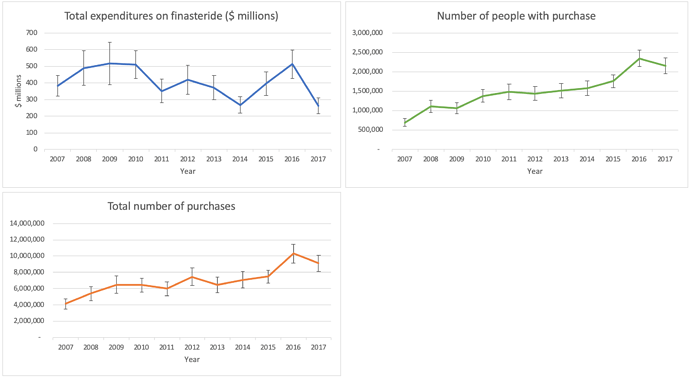I will try to remember where I saw that number. I might be wrong about it but I will look. In the meantime, check out this paper. It has a lot of fancy stats.
Persistent erectile dysfunction in men exposed to the 5α-reductase inhibitors, finasteride, or dutasteride
Tina Kiguradze, William H. Temps, […], and Steven M. Belknap
Abstract
Importance
Case reports describe persistent erectile dysfunction (PED) associated with exposure to 5α-reductase inhibitors (5α-RIs). Clinical trial reports and the manufacturers’ full prescribing information (FPI) for finasteride and dutasteride state that risk of sexual adverse effects is not increased by longer duration of 5α-RI exposure and that sexual adverse effects of 5α-RIs resolve in men who discontinue exposure.
Objective
Our chief objective was to assess whether longer duration of 5α-RI exposure increases risk of PED, independent of age and other known risk factors. Men with shorter 5α-RI exposure served as a comparison control group for those with longer exposure.
Design
We used a single-group study design and classification tree analysis (CTA) to model PED (lasting ≥90 days after stopping 5α-RI). Covariates included subject attributes, diseases, and drug exposures associated with sexual dysfunction.
Setting
Our data source was the electronic medical record data repository for Northwestern Medicine.
Subjects
The analysis cohorts comprised all men exposed to finasteride or dutasteride or combination products containing one of these drugs, and the subgroup of men 16–42 years old and exposed to finasteride ≤1.25 mg/day.
Main outcome and measures
Our main outcome measure was diagnosis of PED beginning after first 5α-RI exposure, continuing for at least 90 days after stopping 5α-RI, and with contemporaneous treatment with a phosphodiesterase-5 inhibitor (PDE5I). Other outcome measures were erectile dysfunction (ED) and low libido. PED was determined by manual review of medical narratives for all subjects with ED. Risk of an adverse effect was expressed as number needed to harm (NNH).
Results
Among men with 5α-RI exposure, 167 of 11,909 (1.4%) developed PED (persistence median 1,348 days after stopping 5α-RI, interquartile range (IQR) 631.5–2320.5 days); the multivariable model predicting PED had four variables: prostate disease, duration of 5α-RI exposure, age, and nonsteroidal anti-inflammatory drug (NSAID) use. Of 530 men with new ED, 167 (31.5%) had new PED. Men without prostate disease who combined NSAID use with >208.5 days of 5α-RI exposure had 4.8-fold higher risk of PED than men with shorter exposure (NNH 59.8, all p < 0.002). Among men 16–42 years old and exposed to finasteride ≤1.25 mg/day, 34 of 4,284 (0.8%) developed PED (persistence median 1,534 days, IQR 651–2,351 days); the multivariable model predicting PED had one variable: duration of 5α-RI exposure. Of 103 young men with new ED, 34 (33%) had new PED. Young men with >205 days of finasteride exposure had 4.9-fold higher risk of PED (NNH 108.2, p < 0.004) than men with shorter exposure.
Conclusion and relevance
Risk of PED was higher in men with longer exposure to 5α-RIs. Among young men, longer exposure to finasteride posed a greater risk of PED than all other assessed risk factors.

